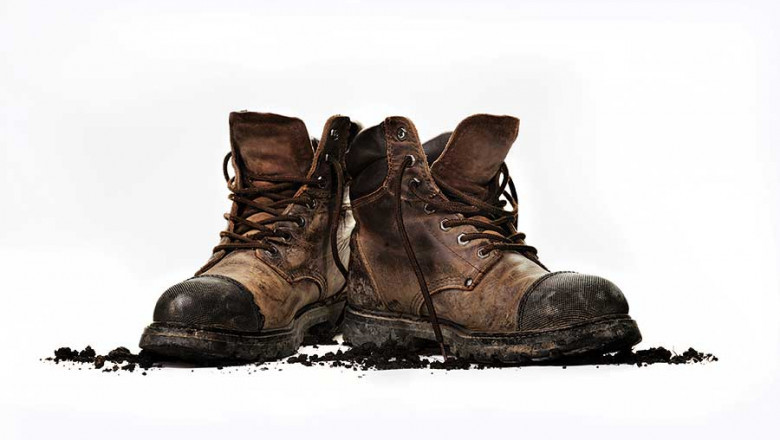views
Steel-Toe Work Boots
Steel-toe boots are one of the most common types of boots. They have a reinforced steel toe that helps protect the feet from hazards like falling objects. Steel toes are required by many workplaces for safety compliance. When shopping for steel-toe boots, look for boots made with compound leather uppers for durability and flexibility. Also check that the steel toe is American Society for Testing and Materials (ASTM) approved.
Waterproof Work Boots
If you work in wet conditions like construction sites, farms, or landscaping, waterproof boots are essential. Look for boots labeled as waterproof, not just water resistant. Fully waterproof boots use materials like Gore-Tex to keep water and moisture out while still allowing vapor to escape. Make sure the seams are fully sealed too. Insulated waterproof boots provide insulation for colder wet work.
Electrical Hazard Work Boots
For those working with electricity, electrical hazard boots provide an extra layer of insulation. Work Boots have insulating material in the soles and uppers rated for a certain level of electrical hazard protection. These boots may be required for jobs like line work or electrical repairs. Check the boot for the insulation rating and that it is American National Standards Institute (ANSI) approved.
Features to Consider
Ankle Support
Boots with taller shafts that come up over the ankles provide more support than boots that end below the ankle. Ankle support is important for jobs like construction that involve a lot of walking, bending, and lifting. Goodyear welted boots allow re-soling and provide lasting support.
Cushioning
Comfort is important for workdays spent on your feet. Look for boots with cushioned insoles, shock absorption in the midsole, and flexibility in the outsole. Replaceable cushioned insoles provide longevity. EVA midsoles offer cushioning that lasts.
Traction
Slip-resistant soles are essential for many work environments. Look for lugs or other tread patterns suited for oil, water, mud, ice, or multiple surfaces. Composite safety toes allow for additional traction features in the sole.
Fit and Comfort
Boots need to fit properly to be comfortable all day. Make sure to try boots on at the end of the day when feet are largest. Boots should hug but not squeeze the foot and ankle. Insoles can customize fit in wider boots. Break boots in slowly at first.
Durability and Materials
For boots to last, focus on quality materials. Leather, especially full-grain leather, provides strength and breathability. Synthetics work well too. Goodyear welted boots allow resoling. Reinforced stitching prevents tearing. Heel pads add comfort as heels wear down over time.
Budget for Work Boot Needs
While durable, high-quality boots do come at a higher price point initially, they save money in the long run by lasting longer between replacements. Expect to pay $100-$300 typically for a great pair of boots depending on features and materials. Buy an extra pair to rotate wear so boots can air out between shifts. Replace insoles yearly and resole as needed for lasting value. Budget annually for new protective footwear based on job needs and replacing worn pairs before safety becomes compromised. Quality, fitting boots are an investment in safety, health, and productivity on the job.
Care and Maintenance Extends Boot Life
Proper care is key to maximizing the lifespan of work boots. Allow boots to fully dry between wear, stuff with paper if needed. Clean regularly with a soft brush to remove dirt. Apply waterproofing spray or sealants as directed. Condition leather as instructed to keep it supple. Replace laces if frayed. Visit a shoe repair shop yearly for new insoles if needed and resoling worn soles before holes form for structural integrity and safety compliance. Storing boots properly when not in use, such as loose in shoe bags, away from heat and light sources, prevents damage over time as well. With dedication to care and repair, work boots can provide years of hardworking performance on job sites.
This covers the main types of work boots, important features to consider, budgeting needs, and maintenance techniques to get the most life out of protective footwear on the job. Durable, comfortably fitting boots are an essential part of safety gear that can make or break a workday. Choosing boots wisely based on job requirements ensures feet stay protected while allowing workers to focus on tasks at hand.
Pick the language that you prefer-
About Author-
Alice Mutum is a seasoned senior content editor at Coherent Market Insights, leveraging extensive expertise gained from her previous role as a content writer. With seven years in content development, Alice masterfully employs SEO best practices and cutting-edge digital marketing strategies to craft high-ranking, impactful content. As an editor, she meticulously ensures flawless grammar and punctuation, precise data accuracy, and perfect alignment with audience needs in every research report. Alice's dedication to excellence and her strategic approach to content make her an invaluable asset in the world of market insights.
(LinkedIn: www.linkedin.com/in/alice-mutum-3b247b137 )






















Comments
0 comment